Canon SX30 vs SX50
The Canon PowerShot SX30 IS and the Canon PowerShot SX50 HS are two digital cameras that were revealed to the public, respectively, in September 2010 and September 2012. Both the SX30 and the SX50 are fixed lens compact cameras that are equipped with a 1/2.3-inch sensor. The SX30 has a resolution of 14 megapixels, whereas the SX50 provides 12 MP.
Below is an overview of the main specs of the two cameras as a starting point for the comparison.

Check SX30 offers at
ebay.com

Check SX50 offers at
ebay.com
Going beyond this snapshot of core features and characteristics, what are the differences between the Canon PowerShot SX30 IS and the Canon PowerShot SX50 HS? Which one should you buy? Read on to find out how these two cameras compare with respect to their body size, their imaging sensors, their shooting features, their input-output connections, and their reception by expert reviewers.
Body comparison
The physical size and weight of the Canon SX30 and the Canon SX50 are illustrated in the side-by-side display below. The two cameras are presented according to their relative size. Three consecutive views from the front, the top, and the rear side are shown. All size dimensions are rounded to the nearest millimeter.
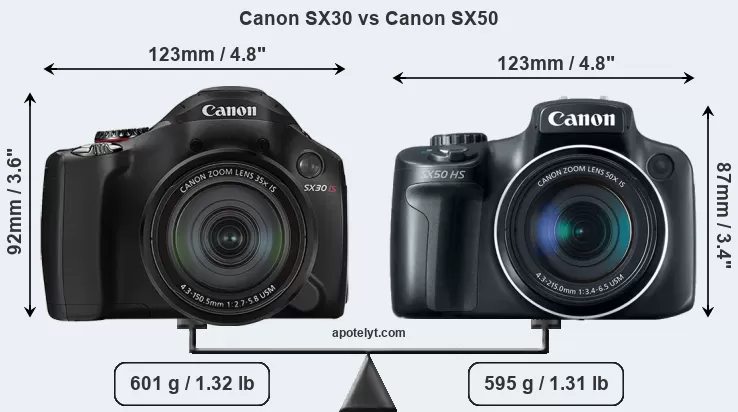
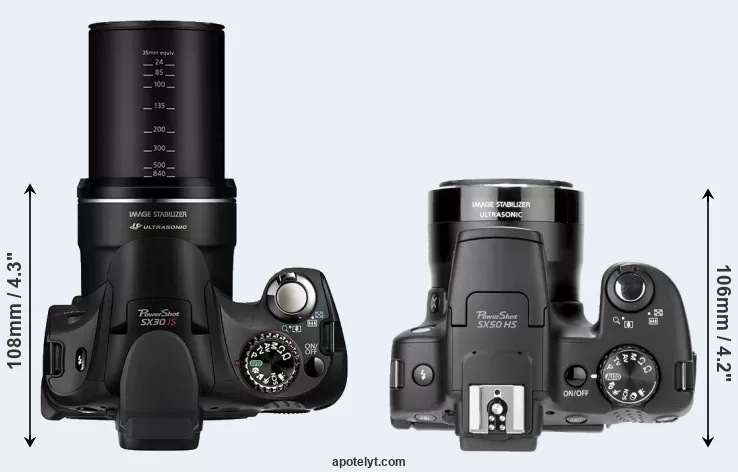
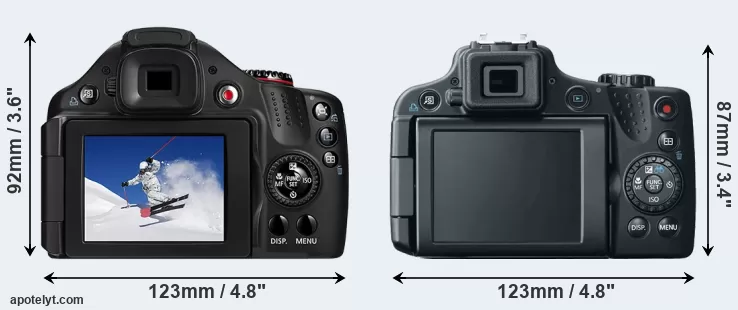
If the front view area (width x height) of the cameras is taken as an aggregate measure of their size, the Canon SX50 is notably smaller (5 percent) than the Canon SX30. Moreover, the SX50 is slightly lighter (1 percent) than the SX30. In this context, it is worth noting that neither the SX30 nor the SX50 are weather-sealed.
Concerning battery life, the SX30 gets 370 shots out of its Canon NB-7L battery, while the SX50 can take 315 images on a single charge of its Canon NB-10L power pack.
The table below summarizes the key physical specs of the two cameras alongside a broader set of comparators. If you want to switch the focus of the display and review another camera pair, you can move across to the CAM-parator tool and choose from the broad selection of possible camera comparisons there.

| # | Camera Model |
Camera Width |
Camera Height |
Camera Depth |
Camera Weight |
Battery Life |
Weather Sealing |
Camera Launch |
Launch Price (USD) |
Street Price |
|
|---|---|---|---|---|---|---|---|---|---|---|---|
| 1. | Canon SX30 | 123 mm | 92 mm | 108 mm | 601 g | 370 | n | Sep 2010 | 429 | ebay.com | |
| 2. | Canon SX50 | 123 mm | 87 mm | 106 mm | 595 g | 315 | n | Sep 2012 | 429 | ebay.com | |
| 3. | Canon SX530 | 120 mm | 82 mm | 92 mm | 442 g | 210 | n | Jan 2015 | 429 | ebay.com | |
| 4. | Canon SX60 | 128 mm | 93 mm | 114 mm | 650 g | 340 | n | Sep 2014 | 549 | ebay.com | |
| 5. | Canon S120 | 100 mm | 59 mm | 29 mm | 217 g | 230 | n | Aug 2013 | 449 | ebay.com | |
| 6. | Canon G15 | 107 mm | 76 mm | 40 mm | 352 g | 350 | n | Sep 2012 | 499 | ebay.com | |
| 7. | Canon SX40 | 123 mm | 92 mm | 108 mm | 600 g | 380 | n | Sep 2011 | 429 | ebay.com | |
| 8. | Canon T3 | 130 mm | 100 mm | 78 mm | 495 g | 700 | n | Feb 2011 | 449 | ebay.com | |
| 9. | Canon SX20 | 123 mm | 88 mm | 87 mm | 600 g | .. | n | Aug 2009 | 399 | ebay.com | |
| 10. | Leica V-LUX 3 | 124 mm | 81 mm | 95 mm | 540 g | 410 | n | Dec 2011 | 949 | ebay.com | |
| 11. | Leica V-LUX 2 | 124 mm | 80 mm | 95 mm | 520 g | 410 | n | Sep 2010 | 849 | ebay.com | |
| 12. | Panasonic FZ150 | 124 mm | 82 mm | 92 mm | 528 g | 410 | n | Aug 2011 | 499 | ebay.com | |
| 13. | Panasonic FZ100 | 124 mm | 82 mm | 92 mm | 540 g | 410 | n | Jul 2010 | 499 | ebay.com | |
| Note: Measurements and pricing do not include easily detachable parts, such as add-on or interchangeable lenses or optional viewfinders. | |||||||||||
Any camera decision will obviously take relative prices into account. The manufacturer’s suggested retail prices give an idea on the placement of the camera in the maker’s lineup and the broader market. The two cameras under review were launched at the same price and fall into the same market segment. Usually, retail prices stay at first close to the launch price, but after several months, discounts become available. Later in the product cycle and, in particular, when the replacement model is about to appear, further discounting and stock clearance sales often push the camera price considerably down.
Sensor comparison
The imaging sensor is at the core of digital cameras and its size is one of the main determining factors of image quality. All other things equal, a large sensor will have larger individual pixel-units that offer better low-light sensitivity, wider dynamic range, and richer color-depth than smaller pixels in a sensor of the same technological generation. Furthermore, a large sensor camera will give the photographer more possibilities to use shallow depth-of-field in order to isolate a subject from the background. On the downside, larger sensors are more costly to manufacture and tend to lead to bigger and heavier cameras and lenses.
Both cameras under consideration feature a 1/2.3-inch sensor and have a format factor (sometimes also referred to as "crop factor") of 5.6. Within the spectrum of camera sensors, this places the review cameras among the smaller-sensor digicams that favor affordability and compact design. Both cameras feature a native aspect ratio (sensor width to sensor height) of 4:3.
Technology-wise, the SX50 uses a more advanced image processing engine (DIGIC 5) than the SX30 (DIGIC 4), with benefits for noise reduction, color accuracy, and processing speed.
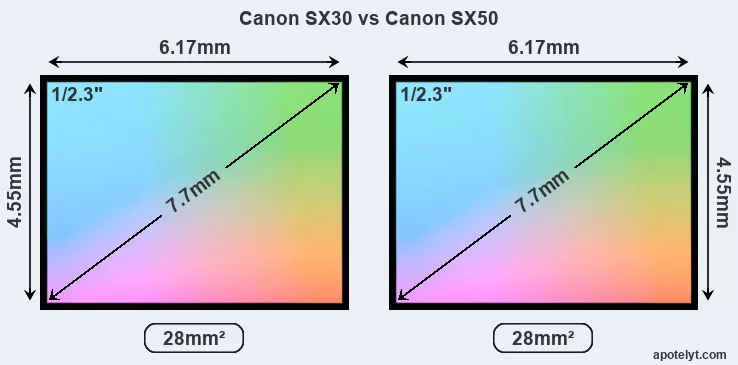
While the two cameras under review share the same sensor size, the SX30 offers a higher resolution of 14 megapixels, compared with 12 MP of the SX50. This megapixels advantage translates into a 8 percent gain in linear resolution. On the other hand, these sensor specs imply that the SX30 has a higher pixel density and a smaller size of the individual pixel (with a pixel pitch of 1.41μm versus 1.53μm for the SX50). Moreover, it should be noted that the SX50 is much more recent (by 2 years) than the SX30, and its sensor will have benefitted from technological advances during this time that further enhance the light gathering capacity of individual pixels. Coming back to sensor resolution, it should be mentioned that the SX30 has no anti-alias filter installed, so that it can capture all the detail its sensor resolves.
The resolution advantage of the Canon SX30 implies greater flexibility for cropping images or the possibility to print larger pictures. The maximum print size of the SX30 for good quality output (200 dots per inch) amounts to 21.6 x 16.2 inches or 54.9 x 41.1 cm, for very good quality (250 dpi) 17.3 x 13 inches or 43.9 x 32.9 cm, and for excellent quality (300 dpi) 14.4 x 10.8 inches or 36.6 x 27.4 cm. The corresponding values for the Canon SX50 are 20 x 15 inches or 50.8 x 38.1 cm for good quality, 16 x 12 inches or 40.6 x 30.5 cm for very good quality, and 13.3 x 10 inches or 33.9 x 25.4 cm for excellent quality prints.
The Canon PowerShot SX30 IS has a native sensitivity range from ISO 100 to ISO 1600, which can be extended to ISO 100-6400. The corresponding ISO settings for the Canon PowerShot SX50 HS are ISO 80 to ISO 6400 (no boost).
In terms of underlying technology, the SX30 is build around a CCD sensor, while the SX50 uses a BSI-CMOS imager. Both cameras use a Bayer filter for capturing RGB colors on a square grid of photosensors. This arrangement is found in most digital cameras.
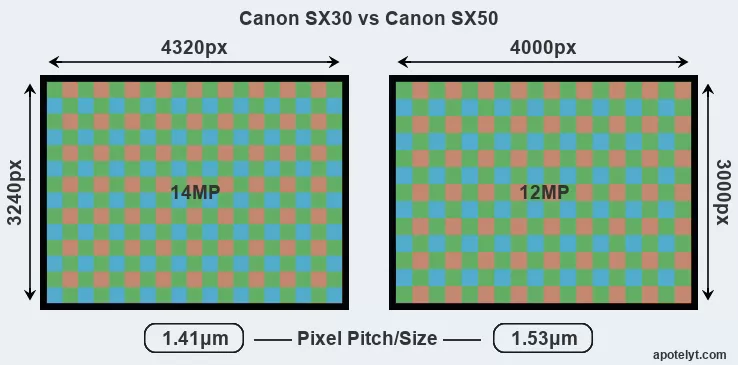
For many cameras, data on sensor performance has been reported by DXO Mark. This service assesses and scores the color depth ("DXO Portrait"), dynamic range ("DXO Landscape"), and low-light sensitivity ("DXO Sports") of camera sensors, and also publishes an overall camera score. The table below summarizes the physical sensor characteristics and sensor quality findings and compares them across a set of similar cameras.

| # | Camera Model |
Sensor Class |
Resolution (MP) |
Horiz. Pixels |
Vert. Pixels |
Video Format |
DXO Portrait |
DXO Landscape |
DXO Sports |
DXO Overall |
|
|---|---|---|---|---|---|---|---|---|---|---|---|
| 1. | Canon SX30 | 1/2.3 | 14.0 | 4320 | 3240 | 720/30p | 19.4 | 10.7 | 320 | 39 | |
| 2. | Canon SX50 | 1/2.3 | 12.0 | 4000 | 3000 | 1080/24p | 20.3 | 11.2 | 179 | 47 | |
| 3. | Canon SX530 | 1/2.3 | 15.9 | 4608 | 3456 | 1080/30p | 20.2 | 11.6 | 712 | 47 | |
| 4. | Canon SX60 | 1/2.3 | 14.2 | 4608 | 3072 | 1080/60p | 19.2 | 10.8 | 127 | 39 | |
| 5. | Canon S120 | 1/1.7 | 12.0 | 4000 | 3000 | 1080/60p | 21.3 | 11.9 | 246 | 56 | |
| 6. | Canon G15 | 1/1.7 | 12.0 | 4000 | 3000 | 1080/24p | 19.9 | 11.5 | 165 | 46 | |
| 7. | Canon SX40 | 1/2.3 | 12.0 | 4000 | 3000 | 1080/24p | 19.6 | 10.9 | 409 | 41 | |
| 8. | Canon T3 | APS-C | 12.2 | 4272 | 2848 | 720/30p | 21.9 | 11.0 | 755 | 62 | |
| 9. | Canon SX20 | 1/2.3 | 12.0 | 4000 | 3000 | 720/30p | 19.2 | 10.5 | 225 | 37 | |
| 10. | Leica V-LUX 3 | 1/2.3 | 12.0 | 4000 | 3000 | 1080/60p | 19.7 | 11.0 | 430 | 42 | |
| 11. | Leica V-LUX 2 | 1/2.3 | 14.0 | 4320 | 3240 | 1080/60i | 19.4 | 10.7 | 321 | 39 | |
| 12. | Panasonic FZ150 | 1/2.3 | 12.0 | 4000 | 3000 | 1080/60p | 19.4 | 10.9 | 132 | 40 | |
| 13. | Panasonic FZ100 | 1/2.3 | 14.0 | 4320 | 3240 | 1080/60i | 19.4 | 10.7 | 306 | 39 | |
| Note: DXO values in italics represent estimates based on sensor size and age. | |||||||||||
Many modern cameras cannot only take still pictures, but also record videos. The two cameras under consideration both have sensors whose read-out speed is fast enough to capture moving pictures, but the SX50 provides a better video resolution than the SX30. It can shoot movie footage at 1080/24p, while the SX30 is limited to 720/30p.
Feature comparison
Beyond body and sensor, cameras can and do differ across a range of features. The SX30 and the SX50 are similar in the sense that both feature an electronic viewfinder, which is helpful when framing images in bright sunlight. Moreover, their viewfinders offer an identical resolution of 202k dots. The adjacent table lists some of the other core features of the Canon SX30 and Canon SX50 along with similar information for a selection of comparators.

| # | Camera Model |
Viewfinder (Type or 000 dots) |
Control Panel (yes/no) |
LCD Specifications (inch/000 dots) |
LCD Attach- ment |
Touch Screen (yes/no) |
Max Shutter Speed * |
Max Shutter Flaps * |
Built-in Flash (yes/no) |
Built-in Image Stab |
|
|---|---|---|---|---|---|---|---|---|---|---|---|
| 1. | Canon SX30 | 202 | n | 2.7 / 230 | swivel | n | 1/3200s | 0.6/s | Y | Y | |
| 2. | Canon SX50 | 202 | n | 3.0 / 461 | swivel | n | 1/2000s | 2.2/s | Y | Y | |
| 3. | Canon SX530 | none | n | 3.0 / 461 | fixed | n | 1/2000s | 1.6/s | Y | Y | |
| 4. | Canon SX60 | 922 | n | 3.0 / 922 | swivel | n | 1/2000s | 6.4/s | Y | Y | |
| 5. | Canon S120 | none | n | 3.0 / 922 | fixed | Y | 1/2000s | 12.1/s | Y | Y | |
| 6. | Canon G15 | optical | n | 3.0 / 922 | fixed | n | 1/4000s | 2.1/s | Y | Y | |
| 7. | Canon SX40 | 202 | n | 2.7 / 230 | swivel | n | 1/3200s | 10.3/s | Y | Y | |
| 8. | Canon T3 | optical | n | 2.7 / 230 | fixed | n | 1/4000s | 3.0/s | Y | n | |
| 9. | Canon SX20 | 202 | n | 2.5 / 230 | swivel | n | 1/3200s | 0.7/s | Y | Y | |
| 10. | Leica V-LUX 3 | 202 | n | 3.0 / 460 | swivel | n | 1/2000s | 12.0/s | Y | Y | |
| 11. | Leica V-LUX 2 | 202 | n | 3.0 / 460 | swivel | n | 1/2000s | 11.0/s | Y | Y | |
| 12. | Panasonic FZ150 | 202 | n | 3.0 / 460 | swivel | n | 1/2000s | 12.0/s | Y | Y | |
| 13. | Panasonic FZ100 | 202 | n | 3.0 / 460 | swivel | n | 1/2000s | 11.0/s | Y | Y | |
| Note: *) Information refers to the mechanical shutter, unless the camera only has an electronic one. | |||||||||||
Both the SX30 and the SX50 have zoom lenses built in. The SX30 has a 24-840mm f/2.7-5.8 optic and the SX50 offers a 24-1200mm f/3.4-6.5 (focal lengths in full frame equivalent terms). Hence, the SX30 and SX50 provide the same view at the wide-angle end, but the SX50 has more tele-photo reach at the long end. The SX30 offers the faster maximum aperture.
Concerning the storage of imaging data, both the SX30 and the SX50 write their files to SDXC cards.
Connectivity comparison
For some imaging applications, the extent to which a camera can communicate with its environment can be an important aspect in the camera decision process. The table below provides an overview of the connectivity of the Canon PowerShot SX30 IS and Canon PowerShot SX50 HS and, in particular, the interfaces the cameras (and selected comparators) provide for accessory control and data transfer.

| # | Camera Model |
Hotshoe Port |
Internal Mic / Speaker |
Microphone Port |
Headphone Port |
HDMI Port |
USB Port |
WiFi Support |
NFC Support |
Bluetooth Support |
|
|---|---|---|---|---|---|---|---|---|---|---|---|
| 1. | Canon SX30 | Y | stereo / mono | - | - | YES | 2.0 | - | - | - | |
| 2. | Canon SX50 | Y | stereo / mono | - | - | mini | 2.0 | - | - | - | |
| 3. | Canon SX530 | - | stereo / mono | - | - | mini | 2.0 | Y | Y | - | |
| 4. | Canon SX60 | Y | stereo / mono | Y | - | mini | 2.0 | Y | Y | - | |
| 5. | Canon S120 | - | stereo / mono | - | - | mini | 2.0 | Y | - | - | |
| 6. | Canon G15 | Y | stereo / mono | - | - | mini | 2.0 | - | - | - | |
| 7. | Canon SX40 | Y | stereo / mono | - | - | YES | 2.0 | - | - | - | |
| 8. | Canon T3 | Y | stereo / mono | - | - | mini | 2.0 | - | - | - | |
| 9. | Canon SX20 | Y | stereo / mono | - | - | YES | 2.0 | - | - | - | |
| 10. | Leica V-LUX 3 | Y | stereo / - | - | - | mini | 2.0 | - | - | - | |
| 11. | Leica V-LUX 2 | Y | stereo / mono | - | - | mini | 2.0 | - | - | - | |
| 12. | Panasonic FZ150 | Y | stereo / - | - | - | mini | 2.0 | - | - | - | |
| 13. | Panasonic FZ100 | Y | stereo / mono | - | - | mini | 2.0 | - | - | - |
Both the SX30 and the SX50 have been discontinued, but can regularly be found used on ebay. The SX30 was replaced by the Canon SX40, while the SX50 was followed by the Canon SX60. Further information on the features and operation of the SX30 and SX50 can be found, respectively, in the Canon SX30 Manual (free pdf) or the online Canon SX50 Manual.
Review summary
So how do things add up? Which of the two cameras – the Canon SX30 or the Canon SX50 – has the upper hand? Is one clearly better than the other? Below is a summary of the relative strengths of each of the two contestants.
Reasons to prefer the Canon PowerShot SX30 IS:
- More detail: Offers more megapixels (14 vs 12MP) with a 8% higher linear resolution.
- Maximized detail: Lacks an anti-alias filter to exploit the sensor's full resolution potential.
- Faster shutter: Has higher mechanical shutter speed (1/3200s vs 1/2000s) to freeze action.
- Better light gathering: Has a lens with a wider maximum aperture (f/2.7 vs f/3.4).
- Longer lasting: Can take more shots (370 versus 315) on a single battery charge.
- More heavily discounted: Has been available for much longer (launched in September 2010).
Arguments in favor of the Canon PowerShot SX50 HS:
- Better moiré control: Has an anti-alias filter to avoid artificial patterns to appear in images.
- Better jpgs: Has a more modern image processing engine (DIGIC 5 vs DIGIC 4).
- Better video: Provides higher definition movie capture (1080/24p vs 720/30p).
- Larger screen: Has a bigger rear LCD (3.0" vs 2.7") for image review and settings control.
- More detailed LCD: Has a higher resolution rear screen (461k vs 230k dots).
- More selfie-friendly: Has an articulated screen that can be turned to be front-facing.
- Faster burst: Shoots at higher frequency (2.2 vs 0.6 flaps/sec) to capture the decisive moment.
- More tele-reach: Has a longer tele-lens for perspective compression and subject magnification.
- More modern: Reflects 2 years of technical progress since the SX30 launch.
If the number of relative strengths (bullet points above) is taken as a guide, the SX50 emerges as the winner of the match-up (9 : 6 points). However, the pertinence of the various camera strengths will differ across photographers, so that you might want to weigh individual camera traits according to their importance for your own imaging needs before making a camera decision. A professional wildlife photographer will view the differences between cameras in a way that diverges from the perspective of a family photog, and a person interested in architecture has distinct needs from a sports shooter. Hence, the decision which camera is best and worth buying is often a very personal one.
How about other alternatives? Do the specifications of the Canon SX30 and the Canon SX50 place the cameras among the top in their class? Find out in the latest Best Superzoom Camera listing whether the two cameras rank among the cream of the crop.
In any case, while the specs-based evaluation of cameras can be instructive in revealing their potential as photographic tools, it says little about, for example, the shooting experience and imaging performance of the SX30 and the SX50 in practical situations. User reviews that are available, for instance, at amazon can sometimes shed light on these issues, but such feedback is all too often partial, inconsistent, and inaccurate.
Expert reviews
This is why expert reviews are important. The following table reports the overall ratings of the cameras as published by some of the major camera review sites (amateurphotographer [AP], cameralabs [CL], digitalcameraworld [DCW], dpreview [DPR], ephotozine [EPZ], photographyblog [PB]). As can be seen, the professional reviewers agree in many cases on the quality of different cameras, but sometimes their assessments diverge, reinforcing the earlier point that a camera decision is often a very personal choice.

| # | Camera Model |
AP score |
CL score |
DCW score |
DPR score |
EPZ score |
PB score |
Camera Launch |
Launch Price (USD) |
Street Price |
|
|---|---|---|---|---|---|---|---|---|---|---|---|
| 1. | Canon SX30 | 3/5 | + + | .. | .. | 3.5/5 | 4/5 | Sep 2010 | 429 | ebay.com | |
| 2. | Canon SX50 | 3/5 | + + | .. | 72/100 | 4.5/5 | 4.5/5 | Sep 2012 | 429 | ebay.com | |
| 3. | Canon SX530 | .. | + + | .. | .. | 4/5 | 4/5 | Jan 2015 | 429 | ebay.com | |
| 4. | Canon SX60 | 3/5 | + + | .. | 75/100 | 4/5 | 4.5/5 | Sep 2014 | 549 | ebay.com | |
| 5. | Canon S120 | .. | + + | .. | .. | 4.5/5 | 4.5/5 | Aug 2013 | 449 | ebay.com | |
| 6. | Canon G15 | 4/5 | + | .. | 76/100 | 4.5/5 | 4.5/5 | Sep 2012 | 499 | ebay.com | |
| 7. | Canon SX40 | .. | + | .. | .. | 4.5/5 | 4/5 | Sep 2011 | 429 | ebay.com | |
| 8. | Canon T3 | .. | 80/100 | .. | 69/100 | 4/5 | 4.5/5 | Feb 2011 | 449 | ebay.com | |
| 9. | Canon SX20 | .. | + + | .. | 73/100 | .. | 4/5 | Aug 2009 | 399 | ebay.com | |
| 10. | Leica V-LUX 3 | .. | .. | .. | .. | .. | .. | Dec 2011 | 949 | ebay.com | |
| 11. | Leica V-LUX 2 | .. | .. | .. | .. | .. | .. | Sep 2010 | 849 | ebay.com | |
| 12. | Panasonic FZ150 | 3/5 | + + | .. | 76/100 | 4/5 | 4.5/5 | Aug 2011 | 499 | ebay.com | |
| 13. | Panasonic FZ100 | .. | + | .. | .. | 4.5/5 | 4.5/5 | Jul 2010 | 499 | ebay.com | |
| Note: (+ +) highly recommended; (+) recommended; (o) reviewed; (..) not available. | |||||||||||
The review scores listed above should be treated with care, though. The assessments were made in relation to similar cameras of the same technological generation. A score, therefore, has to be seen in close connection to the price and market introduction time of the camera, and rating-comparisons among cameras that span long time periods or concern very differently equipped models make little sense. Also, please note that some of the review sites have changed their methodology and reporting over time.

Check SX30 offers at
ebay.com

Check SX50 offers at
ebay.com
Other camera comparisons
Did this review help to inform your camera decision process? In case you are interested in seeing how other cameras pair up, just make a corresponding selection in the search boxes below. Alternatively, you can follow any of the listed hyperlinks for comparisons that others found interesting.
- Canon 1300D vs Canon SX30
- Canon 2000D vs Canon SX30
- Canon 500D vs Canon SX30
- Canon M10 vs Canon SX30
- Canon Rebel vs Canon SX50
- Canon SL1 vs Canon SX50
- Canon SX30 vs Canon SX740
- Canon SX30 vs Panasonic FZ100
- Canon SX50 vs Canon XSi
- Canon SX50 vs Nikon D40X
- Canon SX50 vs Panasonic G5
- Canon SX50 vs Panasonic GX800
Specifications: Canon SX30 vs Canon SX50
Below is a side-by-side comparison of the specs of the two cameras to facilitate a quick review of their differences and common features.
| Camera Model | Canon SX30 | Canon SX50 |
|---|---|---|
| Camera Type | Fixed lens compact camera | Fixed lens compact camera |
| Camera Lens | 24-840mm f/2.7-5.8 | 24-1200mm f/3.4-6.5 |
| Launch Date | September 2010 | September 2012 |
| Launch Price | USD 429 | USD 429 |
| Sensor Specs | Canon SX30 | Canon SX50 |
| Sensor Technology | CCD | BSI-CMOS |
| Sensor Format | 1/2.3" Sensor | 1/2.3" Sensor |
| Sensor Size | 6.17 x 4.55 mm | 6.17 x 4.55 mm |
| Sensor Area | 28.0735 mm2 | 28.0735 mm2 |
| Sensor Diagonal | 7.7 mm | 7.7 mm |
| Crop Factor | 5.6x | 5.6x |
| Sensor Resolution | 14 Megapixels | 12 Megapixels |
| Image Resolution | 4320 x 3240 pixels | 4000 x 3000 pixels |
| Pixel Pitch | 1.41 μm | 1.53 μm |
| Pixel Density | 49.86 MP/cm2 | 42.74 MP/cm2 |
| Moiré control | no AA filter | Anti-Alias filter |
| Movie Capability | 720/30p Video | 1080/24p Video |
| ISO Setting | 100 - 1,600 ISO | 80 - 6,400 ISO |
| ISO Boost | 100 - 6,400 ISO | no Enhancement |
| Image Processor | DIGIC 4 | DIGIC 5 |
| DXO Sensor Quality (score) | .. | 47 |
| DXO Color Depth (bits) | .. | 20.3 |
| DXO Dynamic Range (EV) | .. | 11.2 |
| DXO Low Light (ISO) | .. | 179 |
| Screen Specs | Canon SX30 | Canon SX50 |
| Viewfinder Type | Electronic viewfinder | Electronic viewfinder |
| Viewfinder Field of View | 100% | 100% |
| Viewfinder Resolution | 202k dots | 202k dots |
| LCD Framing | Live View | Live View |
| Rear LCD Size | 2.7inch | 3.0inch |
| LCD Resolution | 230k dots | 461k dots |
| LCD Attachment | Swivel screen | Swivel screen |
| Shooting Specs | Canon SX30 | Canon SX50 |
| Focus System | Contrast-detect AF | Contrast-detect AF |
| Continuous Shooting | 0.6 shutter flaps/s | 2.2 shutter flaps/s |
| Fill Flash | Built-in Flash | Built-in Flash |
| Storage Medium | SDXC cards | SDXC cards |
| Single or Dual Card Slots | Single card slot | Single card slot |
| UHS card support | no | no |
| Connectivity Specs | Canon SX30 | Canon SX50 |
| External Flash | Hotshoe | Hotshoe |
| USB Connector | USB 2.0 | USB 2.0 |
| HDMI Port | YES HDMI | mini HDMI |
| Wifi Support | no Wifi | no Wifi |
| Body Specs | Canon SX30 | Canon SX50 |
| Battery Type | Canon NB-7L | Canon NB-10L |
| Battery Life (CIPA) | 370 shots per charge | 315 shots per charge |
| Body Dimensions |
123 x 92 x 108 mm (4.8 x 3.6 x 4.3 in) |
123 x 87 x 106 mm (4.8 x 3.4 x 4.2 in) |
| Camera Weight | 601 g (21.2 oz) | 595 g (21.0 oz) |

Check SX30 offers at
ebay.com

Check SX50 offers at
ebay.com
Did you notice an error on this page? If so, please get in touch, so that we can correct the information.

